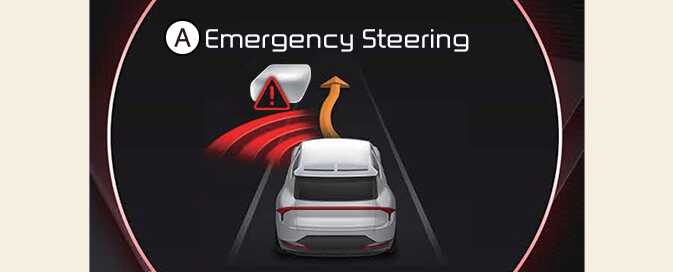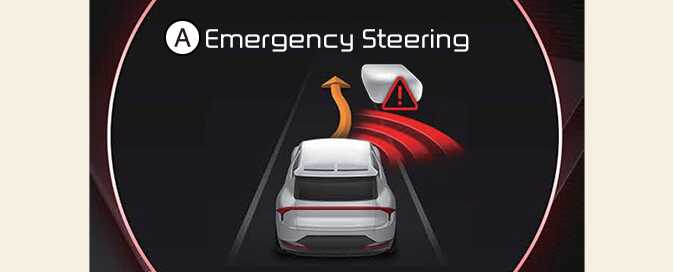Emergency Steering (Evasive steering assist)


A: Emergency Steering
To warn the driver that emergency steering will be assisted, the warning message will appear on the cluster, an audible warning will sound and the steering wheel will vibrate (if equipped). If there is high risk of collision with a pedestrian or cyclist in front, and the vehicle speed to operate emergency braking is within the operation range, the steering will be assisted to help prevent collision when there is space to avoid collision in the driving lane.
Emergency Steering will be activated in following conditions.
-
Your driving speed: 40~47 mph (65~75 km/h)
-
The steering wheel may turn automatically when emergency steering is operating.
-
Emergency steering will automatically cancel when risk factors disappear. If necessary, the driver must steer the vehicle.
-
Emergency steering may not operate or may cancel during operation if the steering wheel is held tight or steered in the opposite direction.
-
When steering is assisted to avoid collision with a vehicle, pedestrian and cyclist, Evasive steering assist will be canceled if collisions with other objects (vehicles, pedestrians, or cyclists) are expected.
-
Evasive steering assist may not operate if space to avoid collision in the driving lane is insufficient.
For more details on warning messages, refer to Collision Warning.
-
For your safety, change the Settings after parking the vehicle at a safe location.
-
With Active Assist or Warning Only selected, when ESC is turned off by pressing and holding the ESC OFF button, Forward Collision-Avoidance Assist will turn off automatically. In this case, Forward Collision-Avoidance Assist cannot be set from the Settings menu and the (
 ) warning light will appear on the cluster which is normal. If ESC is turned on by pressing the ESC OFF button again, Forward Collision-Avoidance Assist will maintain the last setting. Forward Collision-Avoidance Assist does not operate in all situations or cannot avoid all collisions.
) warning light will appear on the cluster which is normal. If ESC is turned on by pressing the ESC OFF button again, Forward Collision-Avoidance Assist will maintain the last setting. Forward Collision-Avoidance Assist does not operate in all situations or cannot avoid all collisions.
-
The driver has primary responsibility to control the vehicle. Do not solely depend on Forward Collision-Avoidance Assist. Rather, maintain a safe braking distance, and if necessary, depress the brake pedal to reduce driving speed or to stop the vehicle.
-
Never deliberately test Forward Collision-Avoidance Assist on people, objects, etc. It may cause serious injury or death.
-
Forward Collision-Avoidance Assist may not operate if the driver depresses the brake pedal to avoid collision.
-
Depending on the road and driving conditions, Forward Collision-Avoidance Assist may warn the driver late or may not warn the driver.
-
During Forward Collision-Avoidance Assist operation, the vehicle may stop suddenly injuring passengers and shifting loose objects. Always wear seat belts on and keep loose objects secured.
-
If any other function's warning message is displayed or audible warning is generated, Forward Collision-Avoidance Assist warning message may not be displayed and audible warning may not be generated.
-
You may not hear the warning sound of Forward Collision-Avoidance Assist if the surroundings are noisy.
-
Forward Collision-Avoidance Assist may turn off or may not operate properly or may operate unnecessarily depending on the road conditions and the surroundings.
-
Even if there is a problem with Forward Collision-Avoidance Assist, the vehicle's basic braking performance will operate normally.
-
During emergency braking, braking control by Forward Collision-Avoidance Assist will automatically cancel when the driver excessively depresses the accelerator pedal or sharply steers the vehicle.
-
Depending on the condition of the vehicle, pedestrian and cyclist in front and the surroundings, or as the recognizable distance is reduced, the speed range to operate Forward Collision-Avoidance Assist may reduce. Forward Collision-Avoidance Assist may only warn the driver, or it may not operate.
-
Forward Collision-Avoidance Assist will operate under certain conditions by determining the risk level based on the condition of the oncoming vehicle, driving direction, speed and surroundings.
-
If your speed is too high or the speed difference with the other vehicle is large, Forward Collision-Avoidance Assist may be limited or may not operate properly.
When a collision with a surrounding vehicle is expected, Lane-Change Oncoming, Lane-Change Side and Evasive Steering Assist functions will only warn the driver.: (if equipped)
-
When a collision is imminent, the Forward Collision-Avoidance Assist may assist the driver with brakes if the driver fails to brake enough.
-
The images or colors may be displayed differently depending on the specifications of the instrument cluster or theme.
